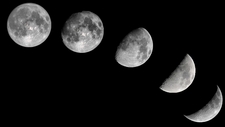Moon Phases
Supporting

TEKS Objective
The student is expected to collect and analyze data to identify sequences and predict patterns of change in shadows, tides, seasons, and the observable appearance of the Moon over time.
Essential Understanding
The student knows that there are recognizable patterns in the natural world and among objects in the sky.
Science Background
Phases of the Moon: K8 Science (video) - Dr. Greg Vogt explains patterns of change in the moon’s appearance, one of the more difficult Earth/space concepts for students to grasp. He describes a simple classroom demonstration that can improve students’ understanding of moon phases.
Phases of the Moon
BioEd Online, www.bioedonline.org
Understanding the Moon Phases: Moon Connection (website) - Explanation of the changing phases of the Moon, accompanied by a clear diagram.
Understanding the Moon Phases
MoonConnection.com
Moon Fact Sheet: National Space Science Data Center (website) - Detailed information about the physical characteristics of Earth and the Moon, the lunar atmosphere, and the Moon’s orbit around Earth.
Moon Fact Sheet
National Space Science Data Center, nssdc.gsfc.nasa.gov
The Moon’s Orbit and Rotation: Windows To The Universe (website) - Description of the Moon’s orbit and an explanation of phases and tidal forces.
The Moon’s Orbit and Rotation
Windows To The Universe, www.windows2universe.org
Signature Lesson
Phases of the Moon: Newton’s Apple (website) - Students learn about the lunar cycle, phases of the Moon, solar time, and other related topics. This activity includes interesting questions for discussion.
Phases of the Moon
Twin Cities Public Television, Newton’s Apple, www.newtonsapple.tv
- Supporting Lessons
- Extensions
- Assessment Ideas
- Literature Connections
- Related
TEKS - Additional Resources
Supporting Lessons
Moon Phases Demonstration: NASA Jet Propulsion Laboratory (website) - Students “act out” the phases of the moon in order to collect and analyze data about patterns of change in its appearance.
Moon Phases Demonstration
NASA Jet Propulsion Laboratory, www.jpl.nasa.gov
Telling Time by the Light of the Moon: Discovery Education (website) - Students learn about phases of the Moon while telling time by the Moon’s position in the sky.
Telling Time by the Light of the Moon
Discovery Education, www.discoveryeducation.com
Elaboration Lessons and Extensions
Make a Crater: NASA Lunar Prospector (website) - Students investigate the role of an impact object’s velocity and mass in determining the size of craters on Earth, the Moon and other celestial bodies in our solar system.
Make a Crater
NASA Lunar Prospector, lunar.arc.nasa.gov
Earth, Moon & Sun Classroom Activities: Morehead Planetarium and Science Center (PDF) -Teacher guide with lessons about the Moon, Earth and Sun from a Native American perspective.
Assessment Ideas
Set up a light in a central location and give each student a white ball to simulate the Moon. Ask students to position their Moon models to represent different phases. Students who understand how the phases are created will move their models into the correct positions. Students who point their models in the wrong direction may need additional assistance to understand Moon phases.
Literature Connections
The Moon. Simon S. (ISBN: 978-0689835636)
Additional Resources
Moon Phases: StarDate (website) - Moon phase calendar, with information about different Moon-related events.
Moon Phases
The University of Texas McDonald Observatory, StarDate, stardate.org
Photojournal: NASA Jet Propulsion Laboratory (website) - Huge collection of downloadable, high-resolution images of the planets.
Photojournal
NASA Jet Propulsion Laboratory, photojournal.jpl.nasa.gov
TEKS Navigation
Grade 4
Need Assistance?
If you need help or have a question please use the links below to help resolve your problem.

Comments